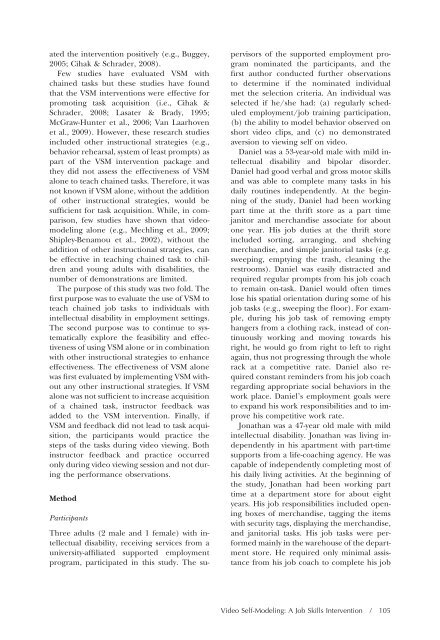etadd_48(1) - Division on Autism and Developmental Disabilities
etadd_48(1) - Division on Autism and Developmental Disabilities
etadd_48(1) - Division on Autism and Developmental Disabilities
You also want an ePaper? Increase the reach of your titles
YUMPU automatically turns print PDFs into web optimized ePapers that Google loves.
ated the interventi<strong>on</strong> positively (e.g., Buggey,<br />
2005; Cihak & Schrader, 2008).<br />
Few studies have evaluated VSM with<br />
chained tasks but these studies have found<br />
that the VSM interventi<strong>on</strong>s were effective for<br />
promoting task acquisiti<strong>on</strong> (i.e., Cihak &<br />
Schrader, 2008; Lasater & Brady, 1995;<br />
McGraw-Hunter et al., 2006; Van Laarhoven<br />
et al., 2009). However, these research studies<br />
included other instructi<strong>on</strong>al strategies (e.g.,<br />
behavior rehearsal, system of least prompts) as<br />
part of the VSM interventi<strong>on</strong> package <strong>and</strong><br />
they did not assess the effectiveness of VSM<br />
al<strong>on</strong>e to teach chained tasks. Therefore, it was<br />
not known if VSM al<strong>on</strong>e, without the additi<strong>on</strong><br />
of other instructi<strong>on</strong>al strategies, would be<br />
sufficient for task acquisiti<strong>on</strong>. While, in comparis<strong>on</strong>,<br />
few studies have shown that videomodeling<br />
al<strong>on</strong>e (e.g., Mechling et al., 2009;<br />
Shipley-Benamou et al., 2002), without the<br />
additi<strong>on</strong> of other instructi<strong>on</strong>al strategies, can<br />
be effective in teaching chained task to children<br />
<strong>and</strong> young adults with disabilities, the<br />
number of dem<strong>on</strong>strati<strong>on</strong>s are limited.<br />
The purpose of this study was two fold. The<br />
first purpose was to evaluate the use of VSM to<br />
teach chained job tasks to individuals with<br />
intellectual disability in employment settings.<br />
The sec<strong>on</strong>d purpose was to c<strong>on</strong>tinue to systematically<br />
explore the feasibility <strong>and</strong> effectiveness<br />
of using VSM al<strong>on</strong>e or in combinati<strong>on</strong><br />
with other instructi<strong>on</strong>al strategies to enhance<br />
effectiveness. The effectiveness of VSM al<strong>on</strong>e<br />
was first evaluated by implementing VSM without<br />
any other instructi<strong>on</strong>al strategies. If VSM<br />
al<strong>on</strong>e was not sufficient to increase acquisiti<strong>on</strong><br />
of a chained task, instructor feedback was<br />
added to the VSM interventi<strong>on</strong>. Finally, if<br />
VSM <strong>and</strong> feedback did not lead to task acquisiti<strong>on</strong>,<br />
the participants would practice the<br />
steps of the tasks during video viewing. Both<br />
instructor feedback <strong>and</strong> practice occurred<br />
<strong>on</strong>ly during video viewing sessi<strong>on</strong> <strong>and</strong> not during<br />
the performance observati<strong>on</strong>s.<br />
Method<br />
Participants<br />
Three adults (2 male <strong>and</strong> 1 female) with intellectual<br />
disability, receiving services from a<br />
university-affiliated supported employment<br />
program, participated in this study. The su-<br />
pervisors of the supported employment program<br />
nominated the participants, <strong>and</strong> the<br />
first author c<strong>on</strong>ducted further observati<strong>on</strong>s<br />
to determine if the nominated individual<br />
met the selecti<strong>on</strong> criteria. An individual was<br />
selected if he/she had: (a) regularly scheduled<br />
employment/job training participati<strong>on</strong>,<br />
(b) the ability to model behavior observed <strong>on</strong><br />
short video clips, <strong>and</strong> (c) no dem<strong>on</strong>strated<br />
aversi<strong>on</strong> to viewing self <strong>on</strong> video.<br />
Daniel was a 53-year-old male with mild intellectual<br />
disability <strong>and</strong> bipolar disorder.<br />
Daniel had good verbal <strong>and</strong> gross motor skills<br />
<strong>and</strong> was able to complete many tasks in his<br />
daily routines independently. At the beginning<br />
of the study, Daniel had been working<br />
part time at the thrift store as a part time<br />
janitor <strong>and</strong> merch<strong>and</strong>ise associate for about<br />
<strong>on</strong>e year. His job duties at the thrift store<br />
included sorting, arranging, <strong>and</strong> shelving<br />
merch<strong>and</strong>ise, <strong>and</strong> simple janitorial tasks (e.g.<br />
sweeping, emptying the trash, cleaning the<br />
restrooms). Daniel was easily distracted <strong>and</strong><br />
required regular prompts from his job coach<br />
to remain <strong>on</strong>-task. Daniel would often times<br />
lose his spatial orientati<strong>on</strong> during some of his<br />
job tasks (e.g., sweeping the floor). For example,<br />
during his job task of removing empty<br />
hangers from a clothing rack, instead of c<strong>on</strong>tinuously<br />
working <strong>and</strong> moving towards his<br />
right, he would go from right to left to right<br />
again, thus not progressing through the whole<br />
rack at a competitive rate. Daniel also required<br />
c<strong>on</strong>stant reminders from his job coach<br />
regarding appropriate social behaviors in the<br />
work place. Daniel’s employment goals were<br />
to exp<strong>and</strong> his work resp<strong>on</strong>sibilities <strong>and</strong> to improve<br />
his competitive work rate.<br />
J<strong>on</strong>athan was a 47-year old male with mild<br />
intellectual disability. J<strong>on</strong>athan was living independently<br />
in his apartment with part-time<br />
supports from a life-coaching agency. He was<br />
capable of independently completing most of<br />
his daily living activities. At the beginning of<br />
the study, J<strong>on</strong>athan had been working part<br />
time at a department store for about eight<br />
years. His job resp<strong>on</strong>sibilities included opening<br />
boxes of merch<strong>and</strong>ise, tagging the items<br />
with security tags, displaying the merch<strong>and</strong>ise,<br />
<strong>and</strong> janitorial tasks. His job tasks were performed<br />
mainly in the warehouse of the department<br />
store. He required <strong>on</strong>ly minimal assistance<br />
from his job coach to complete his job<br />
Video Self-Modeling: A Job Skills Interventi<strong>on</strong> / 105
















